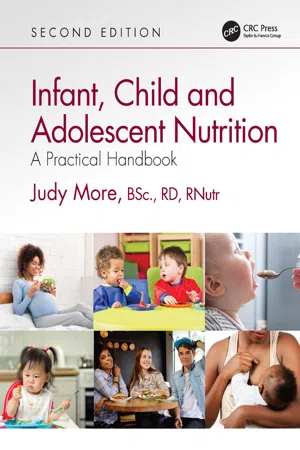
- 300 pages
- English
- ePUB (mobile friendly)
- Available on iOS & Android
About this book
Infant, Child and Adolescent Nutrition: A Practical Guide, Second Edition, is an evidence-based, practical guide introducing readers to the theory behind optimal child nutrition. Containing practical advice on how to put that theory into practice, this new edition facilitates learning through case studies, key points, and learning activities. Divided into seven sections, chapters cover prenatal nutrition and nutrition throughout childhood from preterm babies to adolescents up to the age of 18.
Sections throughout focus on topics ranging from nutrient requirements, balanced eating patterns and common problems to cultural influences on food choices and guidelines on assessing growth and dietary intakes. Prevention and management of obesity and allergies are covered in separate chapters. The first 1000 days are given particular consideration with chapters on diets for preconception, pregnancy, milk feeding and complementary feeding during infancy. The chapter on nutritional treatments covers common conditions such as diabetes and Crohn's disease, as well as more intricate feeding regimes and tube feeding required for children with rarer diseases and syndromes.
New in this second edition are:
· Changes in in food allergy prevention and oral immunotherapy treatments.
· Causes and management strategies to deal with fussy and selective eating in toddlers.
· The importance of iodine in diets before and during pregnancy to improve children's cognitive abilities.
· Updated recommendations on vitamin D supplementation.
This second edition is an essential reading for students taking courses in nutrition and paediatric healthcare. It serves as a useful reference for individuals responsible for the nutritional intakes of children in primary care and community settings including early years practitioners, midwives, health visitors, school nurses and governors, social workers, paediatricians and general practitioners.
About the Author
Judy More BSc, RD, RN is a Paediatric Dietitian, Honorary Lecturer at the University of Plymouth, UK and Director of Child-nutrition.co.uk Ltd, London, UK.
Frequently asked questions
- Essential is ideal for learners and professionals who enjoy exploring a wide range of subjects. Access the Essential Library with 800,000+ trusted titles and best-sellers across business, personal growth, and the humanities. Includes unlimited reading time and Standard Read Aloud voice.
- Complete: Perfect for advanced learners and researchers needing full, unrestricted access. Unlock 1.4M+ books across hundreds of subjects, including academic and specialized titles. The Complete Plan also includes advanced features like Premium Read Aloud and Research Assistant.
Please note we cannot support devices running on iOS 13 and Android 7 or earlier. Learn more about using the app.
Information
Section 1

1
Water
Energy
Table of contents
- Cover
- Half Title
- Title Page
- Copyright Page
- Contents
- Preface
- Author Bio
- Section 1: Nutritional requirements and healthy eating
- Section 2: Assessment of growth and nutritional intake
- Section 3: Prenatal nutrition
- Section 4: Infants: 0–12 months
- Section 5: Preschool children: 1–4 years
- Section 6: School-age children
- Section 7: Nutrition for chronic conditions
- Appendix 1: Function and Food Sources of Nutrients
- Appendix 2: Growth Charts
- Appendix 3: BMI and Waist Circumference Charts
- Glossary
- Index